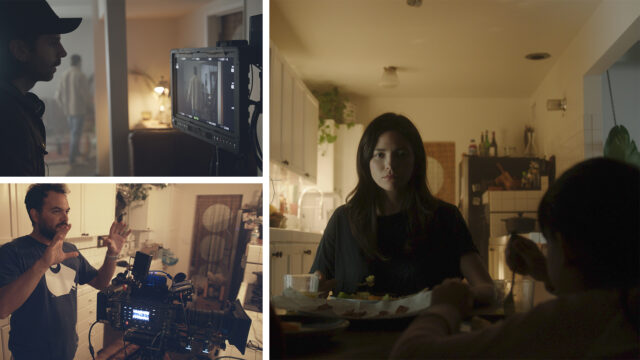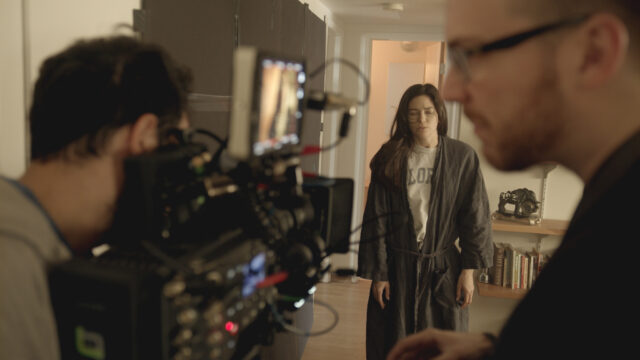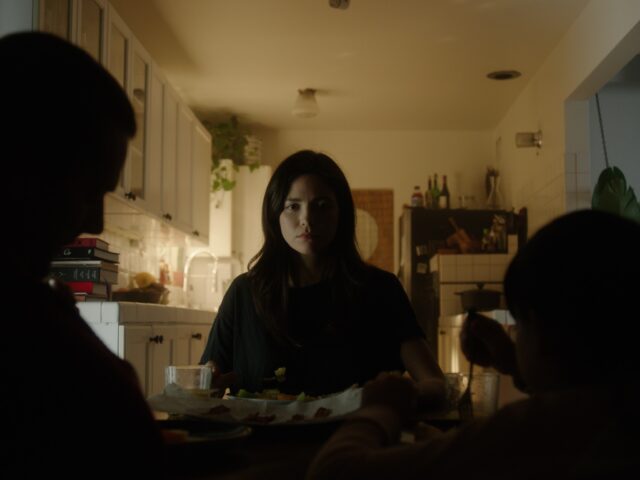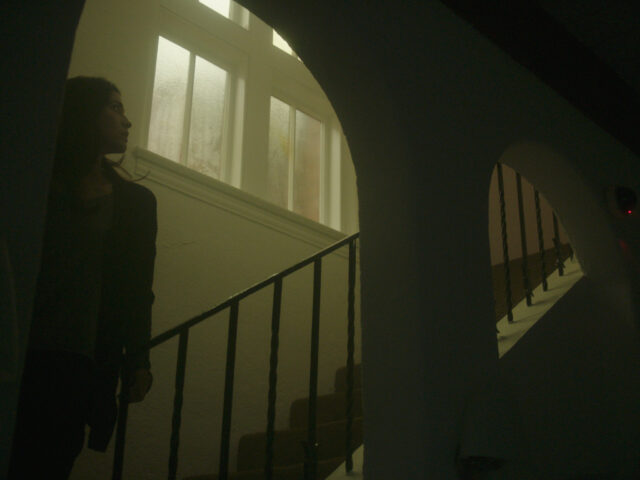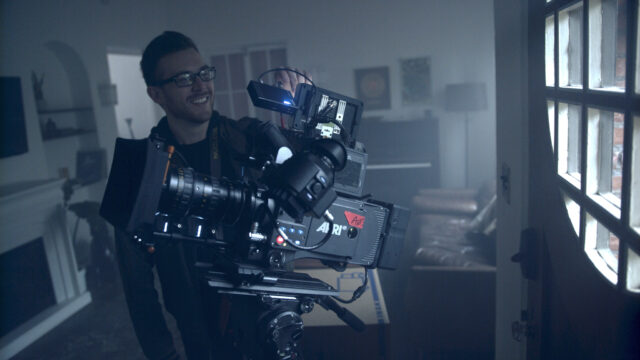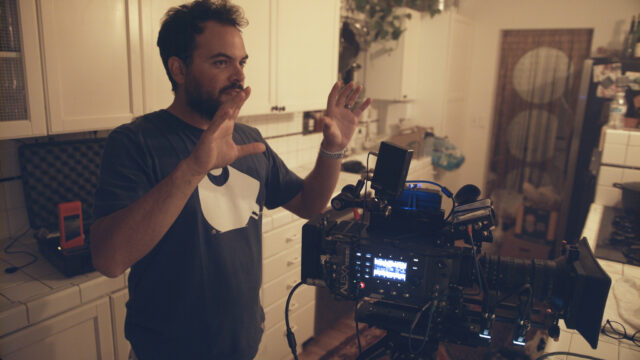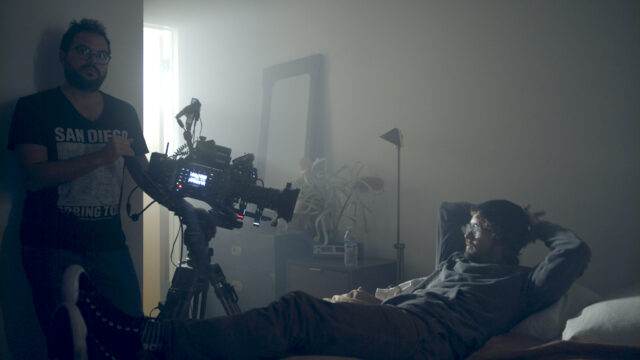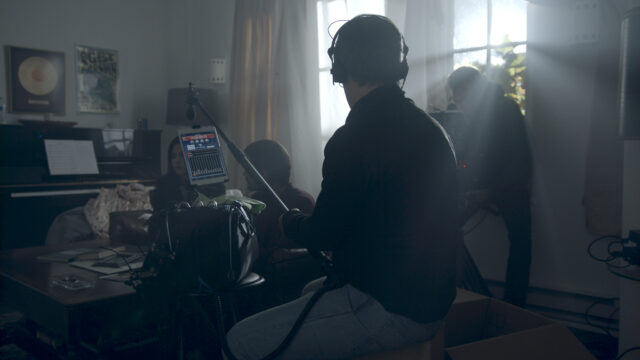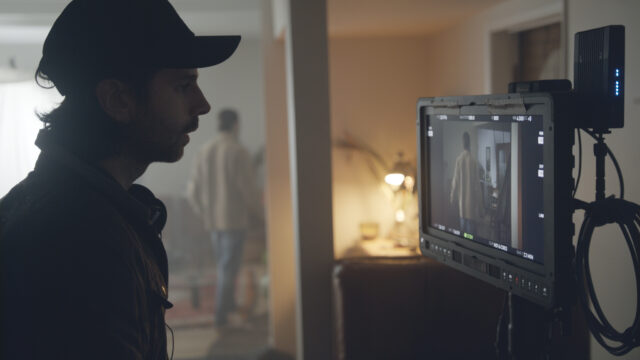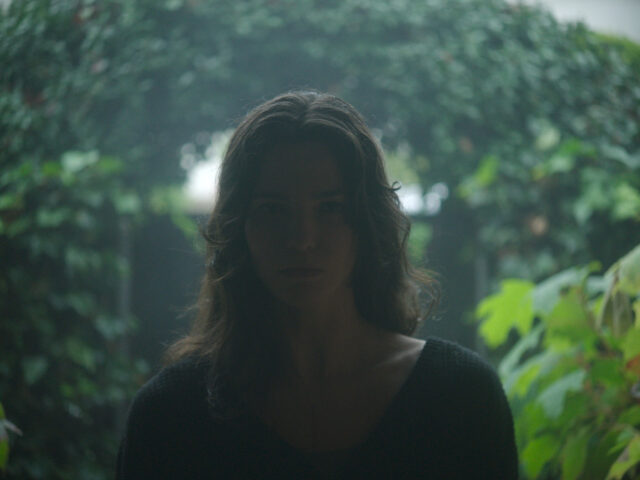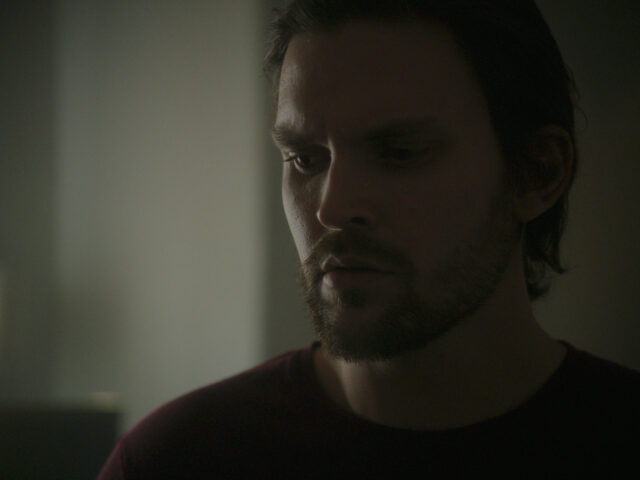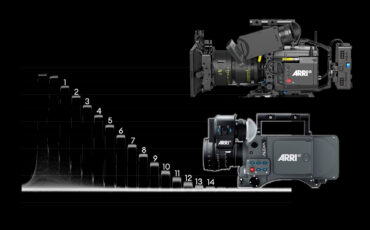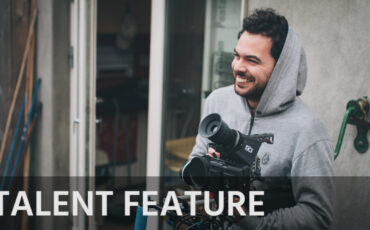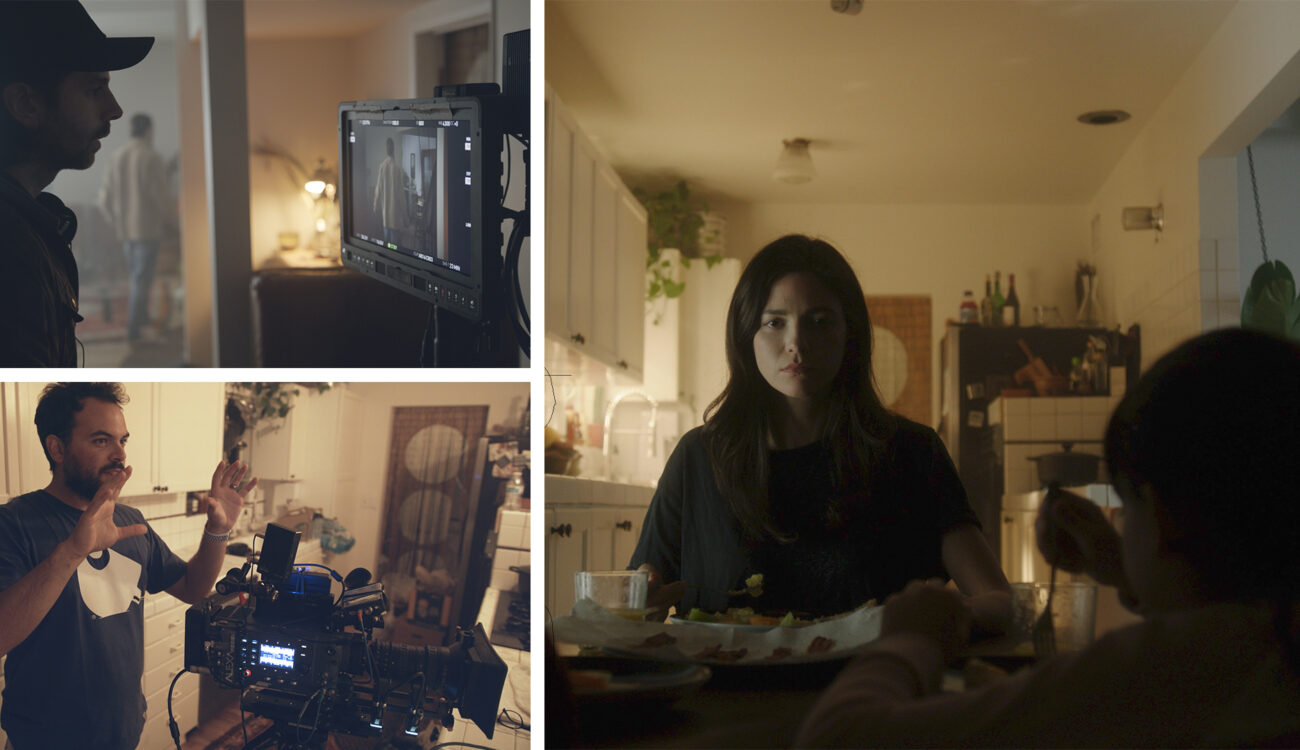
Noam Kroll and D.P. Matteo Bertoli buck the 4K+ trend, choosing to shoot Noam’s feature “White Crow” in 2K on the ARRI Alexa Classic.
Many of you may know Noam Kroll from his blog, website and projects to date. When the production work started on his feature “White Crow”, we immediately reached out to him for some insight into his technical and creative choice to buck the resolution frenzy and shoot 2K with the ARRI Alexa Classic. We also wanted to find out how this choice impacted a low budget, small crew production on a short, tight schedule. All images are courtesy of Noam Kroll.
We sent Noam and his D.P. on the film, Matteo Bertoli some questions to dig a little deeper.
Practical Considerations
One of the first things to consider when deciding on a camera and on-set workflow for a particular project is all the practicalities of the production. What is the shooting schedule like? How many locations are there? How many setups in a day? Size of crew, lighting plan. This all comes down to time and resource management.
Tell us a little bit about the White Crow production. What was the schedule like? Crew size? Locations?
Noam:
White Crow was designed to be shot with minimal cast, crew, and locations, and the screenplay was very much written with practicality in mind. Half the film takes place in one location (the protagonist’s home) and the other half takes place in the antagonist’s house, which made scheduling really easy. We shot everything in only 9 days with a crew of 9 – 10, depending on the day. Normally, when you shoot close to 10 pages per day, you have to work so fast that shots get sacrificed or overall quality goes down, but we really managed to avoid those issues – mainly because we weren’t shooting a lot of coverage, and had actors who were unbelievably prepared. So while we didn’t go for quantity (in terms of shots or coverage), we did achieve quality by taking our time and not rushing through key creative decisions.
Matteo:
The schedule was in theory very, very tight – we shot 81 pages in 9 days with one camera and a very small crew. The crew was composed of: director, 1st AD, DP, producer, 1st AC, gaffer, makeup artist, production designer and wardrobe. In the camera department we were pretty much 3 people! We shot in 2 locations (two houses) and a couple of shots outside. I think the reason why we were able to pull off a feature film in only 9 days is because Noam had a very clear idea of how to shoot the film. Very little, if close to zero coverage, zoom lenses, a lot of one shot, long takes. It’s definitely a very artistic movie and it was shot in a very unique and different way, I love it!
The Desired Look
How easy it is to create the style and look you envision for a project can be an important consideration. A lot can be done in post in terms of color and finishing, regardless of the camera, as long as it provides enough image information to work with, but a particular camera system may get you there at least halfway, with less work. Color rendition and dynamic range, as well as recording format are usually top considerations.
What is the visual style/look you went for in the film; did this play into your choice of camera, aspect ratio, format etc?
Noam:
Before I even wrote the script, I pictured this concept existing in a 4:3 aspect ratio. While the film takes place in present day, it draws influence from many classic films (in particular Ingmar Bergman’s Persona), which made brilliant use of the more traditional aspect. 4:3 can be used to impose an incredible sense of claustrophobia on the viewer, and given the nature of our character (and her psychological turmoil), it was the perfect complement to this piece. I spoke about this idea with Matteo early on, and he concurred it was the way to go. I also wanted the film to have a very analog feel to it, as it deals with the subject of a human heart transplant, and anything too digital looking could have made the film feel too clinical. For that reason, the ARRI Alexa was the clear choice of camera – and paired with our Optimo Zoom lenses, it really delivered the look we were after.
Matteo:
When I jumped on board, Noam had already had a clear vision about how the movie needed to be shot. He sent over some references and told me he wanted to shoot 4:3 with the camera on a tripod for the entire movie. I asked him “why 4:3?” and he gave a really good answer, so I was like, sure, let’s do it! I originally thought about shooting on a Zeiss Standard speed, but then he told me we needed some zoom shots, so we went for two Optimo zooms, 16-42 and 30-80. And this was a very smart choice, since we also saved a lot of time, because we basically didn’t have to change lenses all the time. We also decided to shoot ProRes 422 HQ, since ProRes on the ARRI looks absolutely fantastic. We only shot 4444 a couple of times, but 98% of the movie was shot in 422 HQ. Regarding the look, Noam told me he wanted a lot of contrast, so we always had a negative fill ready to go and there is a lot of contrast on the talent’s faces. We also shot everything quite darkly, were very underexposed, but we loved the look.
The Question of Resolution
For better or worse, resolution is, of course, the one topic that every camera discussion revolves around. Everyone has an opinion, and there’s a good deal of real science and pseudo science out there, when it comes to just how many K’s are enough. For Noam and Matteo, knowing they had better pixels to work with meant more than just having more pixels.
Your decision to employ an ARRI Alexa Classic, and shoot 2K stands out in the current full frame, resolution frenzy. What was your thought process in making this decision?
Noam:
I’ve shot almost every project over the past 5 years (including another feature film) in 4K, but can’t say that it has ever truly made a difference in my work. There was a time when I was genuinely concerned that shooting in HD or 2K would date my work, just as SD footage became dated in the early days of HD, but I’ve long since gotten over that fear. Not that there’s anything wrong with 4K, of course – but to me, it’s no indication of quality. I can shoot 4K on my iPhone, but that doesn’t mean it’s better suited to shoot a feature film on than with an Alexa Classic – the overall quality isn’t nearly in the same universe. Camera choice always just comes down to personal preference, and from my point of view, there is no beating the Alexa if you shoot digitally. It just offers the most organic digital image out there, and doesn’t require extra pixels to do so. I recently purchased an Alexa Plus 4:3 for my company through ARRI’s incredible CPO program, so it was a no brainer to use it for this production.
Matteo:
Well, I absolutely love the look of the Classic, I shot a bunch of commercials on the Mini and the Classic before and for some reason I always loved the classic better, even if they share pretty much the same sensor – maybe it’s because the classic shoots only 2K and so it’s less sharp, I don’t know. But basically, what happened is that Noam just recently bought a Classic 4:3 from the ARRI Certified Program and when he told me I said: “Ok, cool, we are gonna use that!” Regarding the resolution and full frame: I honestly don’t care. We shot Super35 for decades and I am totally fine with that. And 4K? I don’t know… I am totally happy with a good full HD or 2K, what I really care about is color science, dynamic range and highlights roll off, and ARRI has the best in the industry, at least in my opinion. I also love how the ARRI sensor handles noise in low light, we literally shot some scenes in complete darkness with just a very little light and I pushed that sensor to 1280 ISO and the footage looks fantastic. The noise on the Alexa almost looks like film grain and I love that.
In a world where everyone seems to be talking about 6K+ and 8K resolution, and digital cinema camera manufacturers have embraced full frame, can you explain your personal thoughts on these trends as a filmmaker?
Noam:
I am all for 6K, 8K, or anything that pushes the science of filmmaking ahead. Resolution may not be high on my hierarchy of needs as a filmmaker, but of course, it’s still an important component of high quality image capture, and I applaud those manufacturers that are pushing pixel count to the limits. I think the trouble filmmakers run into is buying into the hype that resolution will make their work better in any objective way. Outside of specialty productions that may genuinely have a need for 6K or 8K, no audience is ever going to care what resolution the movie they are watching has. As long as it looks great to their eye, that’s all that matters. If all else is equal and you can shoot in 4K, you may as well go for it – why not have high resolution files if you can? But if you’re deciding between two cameras, and one is inferior in every single way except for its resolution, it wouldn’t make sense to choose to lesser camera, simply because it records its images in a bigger container.
Matteo:
Well, The most common capture format at the Oscars is ARRIRAW 3.8K. There are definitely situations where you might need extra resolution, maybe product shots, or some type of scenes that require VFX, but again, I just don’t care about resolution, I care more about other things. Regarding full frame: I don’t know, I think it’s just a pain in the butt for rental companies, because they have to invest in new lenses, but on the other side, I am pretty sure the S35 won’t go away anytime soon. It’s probably awesome for landscapes and that kind of shots. I am not opposed to it, I just don’t feel the need for it now, or probably none of the projects I worked on required that kind of look. But honestly, If I need to shoot an extra sharp or extra real movie, I’ll just pick up the best tool to tell that story in the best way possible, and in that case I might have to shoot full frame 8K, who knows? We have plenty of tools available nowadays, we just need to pick the right one!
While these may well be technical innovations in terms of sensor design and image processing, do they really improve the art? Are camera manufacturers innovating to benefit the art or is this just the business cycle of manufacturing demand for new products? Could it be some of both?
Noam:
If anything, a lot of the technological advancements we’ve seen in recent years are adversely affecting the creative process. Shooting on the Alexa Classic in 2K was a dream, as the ProRes files were small, transfer time was minimal, no proxies were needed in post, and the editing session was set up in record time. This type of frictionless workflow is ideal for filmmakers that need to maintain a certain sense of momentum on set and off, and you’re just not going to have the same experience with 8K RAW files – unless, of course, you happen to also run a post-house. That’s why I admire companies like ARRI, who make products that enhance the creative process, by not only delivering incredible performance, but also reliability and ease of use.
Matteo:
I am a big believer in the theory that a camera is just a tool. As I said before, we have to be careful and pick the right one. A lot of people are shooting movies on iPhones, which is insane, if you think about it. You can actually shoot anamorphic on iPhone! Isn’t it crazy? There is definitely a lot of marketing in this resolution madness… I mean, 8K! That sounds cool no? But again, it might have its advantages, I don’t know. But art is art and you can make art with literally anything, nowadays!
The Alexa Classic On Set
A camera system and associated data workflow is one thing on paper, yet how it performs under the pressure of production is what really matters.
How did the Alexa Classic perform practically on set, with a small crew and tight shooting schedule?
Noam:
From my vantage point, the Alexa was an absolutely treat to work with – but then again, I had the best crew I could ask for, and owe my DP (Matteo Bertoli) a huge “thank you” for making it all so seamless. That said, even from his perspective, it seemed like the camera made things more streamlined for us in many respects. Because the Alexa’s color science and dynamic range is so incredible, we spent less time tweaking lights and settings in camera, and more time shooting. ARRI’s cameras have this ability to make everything look just a bit better than it does to your eye – so having that luxury definitely allowed us to work faster, without ever sacrificing quality. And even though the Alexa Classic Plus is larger and heavier than most other digital cinema cameras today, that wasn’t an issue for us at all. We were on sticks for every shot, and didn’t have a ton of setups on the schedule. Unless you are shooting handheld, a heavier camera can often be more of an asset than a liability in that it forces you to work in a more traditional way.
Matteo:
Well, the Classic is a tank! You definitely need a huge tripod and a 1st AC, even if I was crazy enough to hike through the forest around the Seattle area by myself, with a Classic and an easy rig to shoot a commercial! Hopefully I won’t have to do that again. But yeah, this movie was actually easy, since we were always inside and always on a tripod. We barely used any batteries, since we were always connected to electricity. But there were some very tight spaces, where I wish I could have used a smaller camera. We actually had a couple of very tricky, but short car scenes. Putting that camera in a car is a pain – it’s just huge! But we made it and we were able to shoot the entire movie on the Classic.
Can you tell us a little about your on-set workflow?
Noam:
We would start each morning by walking through every scene we had to shoot that day, and then would make tweaks to the schedule if anyone had suggestions to improve efficiency. After a quick blocking with the actors, Matteo and his team would get the camera and lights set up, while I would continue to rehearse with the actors and dial in the performances. That way, once we would start rolling, the actors were able to nail the scenes in 2 or 3 takes. There were some instances where we needed 8 or 9 takes for certain shots, but thankfully, those were few and far between. The only added challenge I had myself was handling the media transfers, as we didn’t have a DIT on set. I had my MacBook Pro with me and two 4TB hard drives that would store all the data on set. Once I got it back to my editing space, I would dump everything on my main RAID system, and then make another copy on an archive drive that I keep in a different location.
Matteo:
I really love location scouting and understanding what I could do in that particular location. What I usually do is show up on set 30 minutes before call time, walk around with the camera, see where the best angle could be, figuring out lighting with my gaffer and then go for it. I am a huge fan of natural light, so I try to use lights only when I really need them. For the night scenes we only used practicals, pretty much, nothing else. In terms of exposure, I typically go by eye and I check false colors just to be safe – even if in this movie, our false were constantly on purple and blue (very underexposed).
Would you recommend the Alexa Classic as a good choice for filmmakers with limited time and budgets to achieve a visual quality that adds value?
Noam:
Absolutely. Shooting with any variation of the Alexa system is a dream – especially for those coming from a DSLR background. The Alexa menu system is so intuitive and simple to learn, and the images the camera produces are just unbeatable. Like any camera choice though, it’s totally subjective – while it may be my first pick, depending on a filmmaker’s creative and practical needs, other cameras may be equally valid options, of course. But for those that do go the Alexa route, it’s hard to ever see it as the wrong choice.
Matteo:
Absolutely! It’s a fantastic camera and you can rent an entire kit for around 300$ a day in L.A. Or you can buy an original Classic on ARRI’s website for around 10-11.000$. You will still need a matte box, filters, batteries and lenses, though.
Do you expect the value in terms of visual qualities to translate well into sales, despite not having a 4K master deliverable?
Noam:
Yes. I directed another feature last year, and of the nearly 40 offers we had from distributors and sales agents, not a single one asked about the film’s resolution before making an offer. Many large scale films are not mastered to 4K either. Today, for example, I saw “The Favourite” by Yorgos Lanthimos (great movie, by the way!). It was shot on 35mm and according to IMDB mastered to 2K, like so many others. If 2K is good enough for wide theatrical releases of major motion pictures, independent filmmakers like myself shouldn’t be afraid of embracing 2K at all!
Matteo:
Oh yeah, absolutely. I think delivering in 2K will be totally enough!
The Right Tool for the Job
It’s so easy to get caught up in all the latest tech and trends, when the best choice may not be something new at all. It may be the workhorse you already have, or a battle-proven camera like the Alexa Classic, that you can rent for a steal.
In summary, it’s refreshing to hear from filmmakers that are balancing all the creative needs and practical limits of a particular project when considering camera and lens choice, on-set workflow and post-production, rather than blindly following trends. While this article is in no way affiliated with ARRI, you can find out more about the official ARRI certified used camera program here.
What are your thoughts on the importance of resolution when making camera and format choices for a project? Let us know in the comments.
